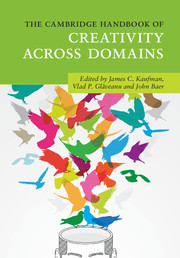Book contents
- The Cambridge Handbook of Creativity Across Domains
- The Cambridge Handbook of Creativity Across Domains
- Copyright page
- Dedication
- Contents
- Figures
- Tables
- Contributors
- Acknowledgments
- Part I Creativity and Domain
- Part II Creativity in the Traditional Arts
- Part III Creativity in the Sciences
- 12 Creativity in the Physical Sciences
- 13 Biomedicine, Creativity, and the Story of AIDS
- 14 Creativity in Psychology
- 15 Creativity in the Engineering Domain
- 16 Creativity in the Domain of Mathematics
- 17 Creativity Within Computer Science
- Part IV Creativity in Business
- Part V Newer Domains for Creativity Research
- Part VI Creativity in Everyday Life
- Part VII Conclusion
- Index
- References
17 - Creativity Within Computer Science
from Part III - Creativity in the Sciences
Published online by Cambridge University Press: 15 September 2017
- The Cambridge Handbook of Creativity Across Domains
- The Cambridge Handbook of Creativity Across Domains
- Copyright page
- Dedication
- Contents
- Figures
- Tables
- Contributors
- Acknowledgments
- Part I Creativity and Domain
- Part II Creativity in the Traditional Arts
- Part III Creativity in the Sciences
- 12 Creativity in the Physical Sciences
- 13 Biomedicine, Creativity, and the Story of AIDS
- 14 Creativity in Psychology
- 15 Creativity in the Engineering Domain
- 16 Creativity in the Domain of Mathematics
- 17 Creativity Within Computer Science
- Part IV Creativity in Business
- Part V Newer Domains for Creativity Research
- Part VI Creativity in Everyday Life
- Part VII Conclusion
- Index
- References
Summary
This chapter focuses on creativity within computer science. We examine what those within the field have said about creativity and how it relates to computer science and to computer scientists. We also look at the results of creativity in the form of products of computer science. We often reference programing both directly and indirectly, but we also address areas of computer science beyond programing whenever possible. We address creativity from the perspective of those within the field. We discuss examples of how creativity in computer science is implemented in areas such as coding, open-source projects, video games, augmented reality, and artificial intelligence. We look at creativity in computer science education as both a method of instruction as well as a desired outcome. We then look at malevolent creativity and how different types of hackers use creativity with either malevolent or benevolent intent.
- Type
- Chapter
- Information
- The Cambridge Handbook of Creativity across Domains , pp. 299 - 322Publisher: Cambridge University PressPrint publication year: 2017
References
- 2
- Cited by



